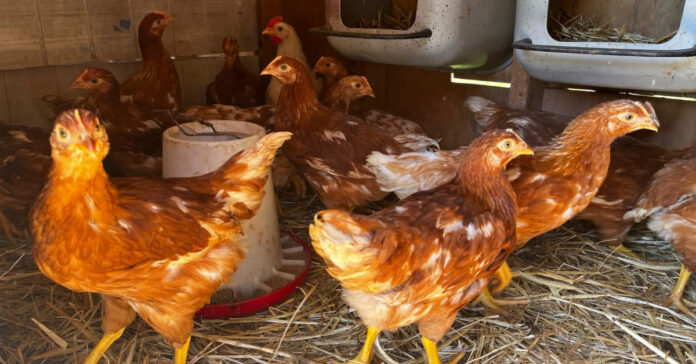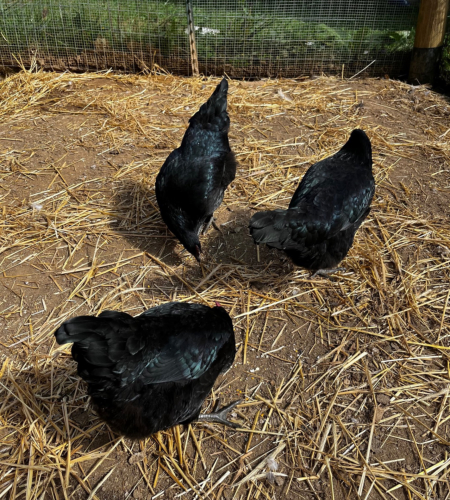
Back in April, I received 12 chicks, gave four to a friend, and somehow had ten left because the hatchery had sent me more than I ordered. Great, I thought, more eggs for me.
When the chicks were about seven weeks old, they had outgrown their brooder and I moved them outside into a section of the chicken run I walled off. The idea was this would allow them to become acquainted with the existing chickens. Unfortunately, this portion of the run did not have a roof. Several chicks flew over the fence between the two sections of the run. The grown up chickens apparently saw them as interlopers and killed them. Then an owl attacked and killed two. At this point, I added protection above the young chickens, but the owl still got another one.
We assume it was an owl because it bit the heads off, but it could have been a raccoon. They do that as well. Still, raccoons have never broken into the coop before, and the electric wires were hot, so I lean towards an owl being the culprit.
By the time the new chickens were large enough to integrate with the old ones and hold their own, I was down to three. These three remaining pullets were tough enough to survive, but they killed one of the older hens in the kerfuffle of integration. That must have been some fight.
I was not expecting this kind of death-rate. Instead of eight new hens, I had three new ones and was minus an old hen.
That’s more losses in two months than I had in the prior two years combined. Nothing I had read in my homesteading and survival books or seen on YouTube lead me to believe there would be such problems integrating the two populations. Maybe it’s because we had roosters.
I decided to start from scratch.
More Chicks
Not one to give up, I ordered 16 hens and one rooster from Murray McMurray. That was close to my initial order two-and-a-half years ago. I got the Red Stars chicks like I did back then.
I decided to get rid of the older Red Stars, which were well into their non-productive stage, meaning they were laying fewer and fewer eggs. Our existing roosters and a hen got “sent to freezer camp,” which is a euphemism for saying we butchered them and stuck them in the freezer. I reported on this in a post about our homestead 101 visitor. After butchering them, I decided I didn’t want to invest the time and energy in killing the 8 remaining hens. An organic gardener I know who sells produce athttps://pickled-prepper.com/2023/08/butchering-and-processing-chickens-on-the-homestead/ the local farmers’ market, recommended a woman who was happy to do it. All I had to do was drop off the chickens. She said I could just pull up to her house and toss them over her fence and into the run.
Now my chickens are not pets. They don’t have names and I rarely handle them. While they will eat scratch from my hand, they don’t like to be petted or picked up. This makes it difficult to catch them, so getting the chickens to the processing lady would be a hassle.
I decided to do it in the middle of the night because when I open the coop at night, they usually just sit on their roosts and stare at me. The dark lulls them and I can snag a chicken off the roost. That worked fine for the first two, but it got more complicated when they figured out what was going on. Number three was the most difficult, but eventually I got them all crammed into a large dog crate. They seemed to prefer it to me holding them.
Did I mention that this all took place at 1 a.m.? Then I went to bed and when I work up in the morning, I dropped them off. When I was doing the transfer, one hen got away, and I had to chase it down. Luckily, she saw her friends inside the new chicken run and wanted to join them. Had she run off randomly, I would have never caught her.
Next steps
Then I cleaned out the coop and added new bedding. The coop was not too bad, but I wanted to start the new chicks off with new bedding. To add insult to injury, when I was dumping the bedding on the compost pile, I got stung three times by angry bees. That will teach me not to wear a red shirt when going near bees.

The three Black Star hens that survived are now old enough to lay eggs and are producing one or two eggs a day. They are small eggs since these are young hens, but they will get bigger as the hens more fully mature. Now I have to integrate the 23-week old Black Stars with the eight-week old Red Stars. If they kill any of the new Red Stars, I’m taking the black ones to the same lady.
I hope that won’t be necessary. I have divided the coop into two, which I designed it to do when I built it. The new chicks are in the bigger section. I am waiting several days to let them out. This ensures that they know where their home is and will go back into the coop to roost at night.
I hope the 16 pullets will have numbers on their side and won’t let the three Black Stars peck them to death. I’d like to think that after being bullied, the Black Stars won’t turn around and bully the new chicks, but that’s anthropomorphizing them. I know better than to expect human behavior or emotions from chickens.
Hoping for More Eggs
If all goes smoothly—and Mr. Murphy is always hovering about—I will have 20 new chickens, 19 of which are hens. For the next couple of months, I should get two or three eggs a day. The new hens should start laying in January. By spring, I hope to be getting 16 or more eggs per day.
Selling seven dozen eggs a week at $5 a dozen will generate some good pocket change.
Revised Egg-onomics
For the first year, the chicks laid eggs frequently, and I calculated my cost per egg was about 15 cents. I was thrilled with this cost. I didn’t realize I should have bought replacement chickens sooner than I had. The one-year-old chickens molted and then slowed their laying for the second winter, and it never fully bounced back. Since we had a bit of attrition, I was getting maybe five or six eggs a day for most of the summer. (The chickens turned two in June.)
My best guess is that at the end of the 30 months, the average cost per egg had doubled to 30 cents over the lifetime of the hen. At $3.60 per dozen, I am still making a profit when I sell a dozen for $5, but when you add in what we eat or give away, I am probably just breaking even. Of course, I am not buying eggs, so I am saving money there. More importantly, the chickens are a prep, and I’m happy to have one prep that pays for itself.
After more than two years, I remain pleased to be keeping chickens and I plan to continue to do so. Once they grow up and are established in the coop, they require little attention, so they are relatively easy to keep. With the electric coop door that uses sunrise and sunset to determine when to open, we can leave them unattended for a couple days if I leave town, as long as they have plenty of feed and water.
As I learned with the ten (now three) Black Stars, the most important thing is to have a well-built chicken coop that does not have holes or other access points for snakes, mink, rats, raccoons, foxes, owls, or other critters that might kill the chickens or eat their eggs. The temporary shelter was not sufficiently secure—my bad. Putting the newest batch of chickens in the main coop should keep them safe.
I’m crossing my fingers, but I’m also trying not to count my chickens before they are hatched.







